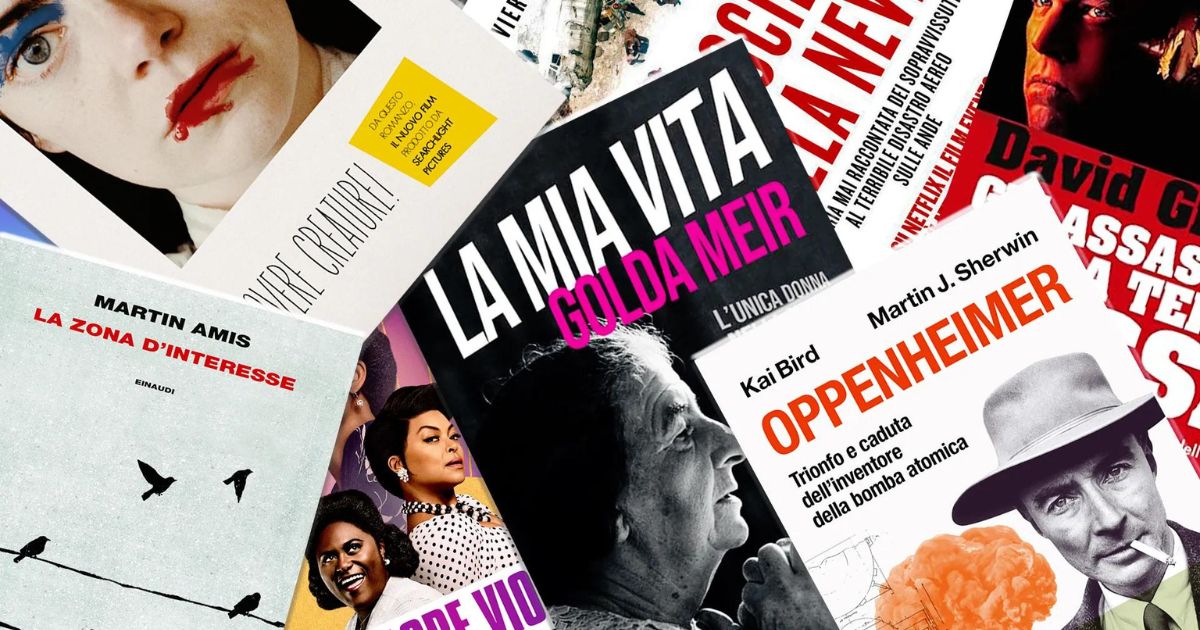A downpour of masterpieces to rediscover as novels as well. Because many of the stories that have arrived on the big screen this year start from these pages, definitely worth catching up on.
We’re almost there. The Academy Awards show is approaching. It’s time to review the titles nominated, but also to read the “Oscar 2024 books,” those that inspired the competing stories.
This year, many nominated titles are adapted from bestsellers or overlooked books of substance. Not to mention characters drawn from pop culture, from the Mattel Barbie doll to the Super Mario Bros video game.
Some stories are drawn from the darkest pages of human history, from the Holocaust to the Osage Native American massacre in the United States, to the creation of the atomic bomb. Other tales are products of pure imagination, but in 2024, stories from our past, the challenges of humanity, and even a touch of rock, with the biopic about Priscilla, Elvis’s widow, will be rewarded.
Here, then, are the ten titles not to be missed for those who want to do more than just give them a cursory glance but delve deep into the origins of the stories that have enchanted audiences and critics:
“Oppenheimer” by Kai Bird

Christopher Nolan has assembled an all-star cast led by Cillian Murphy. From Matt Damon to Robert Downey Jr., no one would have missed the colossal of the moment. Based on a tragically true story, the creation of the atomic bomb, the film was released in the summer and achieved record box office receipts, also thanks to the rather unusual collaboration with Barbie.
On paper, it’s a challenging, detailed, and technical project, seemingly aimed at a select few, but that’s not the case.
The novel meticulously traces Oppenheimer’s life to the point of winning the Pulitzer Prize in 2006. And the film gives this challenge an epic tone because it’s based on the compromises – even moral ones – that the group of scientists must face as they proceed with the creation of a weapon of mass destruction.
“The Zone of Interest” by Martin Amis

Imagine a residential neighborhood with well-tended lawns and tidy houses. Children play happily, and mothers stroll around. It could be an idyllic place in any part of the world, but instead, it’s the so-called Kat Zet. Since filmmaker Jonathan Glazer became aware of it, he wanted to tell its story in a film, now nominated for 5 Oscars, with the same title as the original book, “The Zone of Interest.” What makes this neighborhood unique isn’t visible: it’s the horror of Auschwitz. The happy little meadow belongs to Nazi officers and their families, and next to them is the concentration camp, with dogs howling, chains rattling, the smoke of the constantly active crematoriums filling the sky with ash. A unique and heartbreaking perspective.
“Poor Things” by Alasdair Gray

Director Yorgos Lanthimos heavily drew from the novel “Poor Things,” which rewrites femininity with a desire for freedom and independence, through the protagonist Bella Baxter, portrayed by Emma Stone, a potential Oscar contender. It’s a kind of female Frankenstein story, where the girl is brought back to life by an extraordinary scientist. From there, begins a journey of self-awareness, wonder, self-discovery, and understanding of the world, with a mix of unpredictable poetry and longing. No man tries to define her when she takes flight.
“The Killers of the Flower Moon” David Grann

Martin Scorsese fought long to bring to the world the story of the massacre that occurred a century ago in the Osage tribe. The director wanted his trusted actors, Leonardo DiCaprio and Robert De Niro, by his side, as well as to shoot in the actual locations of the killings. White men seized the oil-rich lands using various schemes and resorting to all kinds of brutality. Native Americans were involved in the production and filming so that this story of the 1920s could be portrayed in all its complexity. The vividness of the pages comes alive frame by frame in “Killers of the Flower Moon” with immeasurable accuracy to shed light on the FBI investigation that exposed the horrors inflicted upon Native American soil.
“The Color Purple” by Alice Walker

Oprah Winfrey isn’t keen on calling it a remake when referring to the new film based on Alice Walker’s Pulitzer Prize-winning novel. Yes, back when Steven Spielberg’s film was released, she played one of the key roles in the story, and yes, it was a career-defining moment for her. However, this reinterpretation with a musical twist and a modern approach brings these incredible artists back together as executive producers of a breathtaking project. The story revolves around two sisters, Celie and Nettie, who share a history of family abuse but end up on different paths. Their lives change dramatically upon meeting the magnetic singer Shug Avery. The cast includes Danielle Brooks (Orange Is the New Black), Halle Bailey (The Little Mermaid), and Taraji P. Henson (Empire).
“My Life” by Golda Meir

Helen Mirren’s portrayal of Israel’s first female Prime Minister sparked controversy, with purists preferring an actress of Jewish origin. Setting aside the criticisms, the film, nominated for an Oscar for makeup that transformed the lead actress to resemble her character as closely as possible, draws from real events and primarily references Golda Meir’s autobiography, of Ukrainian origin. This extraordinary figure engaged with the most influential politicians and personalities in history, confronting leaders like American President Kennedy and Pope Paul VI, just to name a few. Golda never shied away, honed by life’s struggle for survival since childhood, facing escape, hunger, and abandonment.
“Society of Snow” by Pablo Vierci






